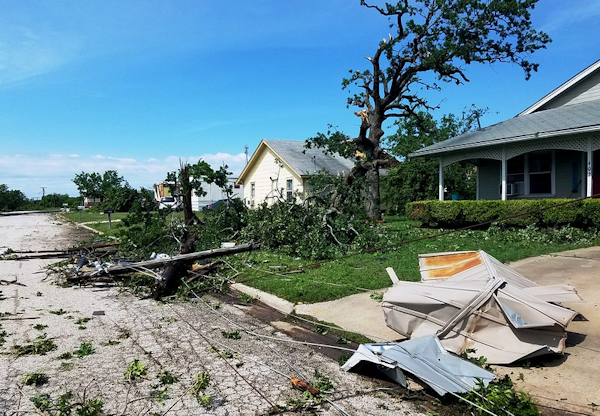SEJournal Online is the digital news magazine of the Society of Environmental Journalists. Learn more about SEJournal Online, including submission, subscription and advertising information.
 |
 |
| Extreme weather is drawing attention to gaps in the home insurance industry, as residences are damaged, but coverage is insufficient or nonexistent. Photo: Gilbert Mercier via Flickr Creative Commons (CC BY-NC-ND 2.0 DEED). |
TipSheet: Home Insurance Likely To Be a 2024 Climate Story Near You
By Joseph A. Davis
Part one of a two-part series addressing extreme weather and insurance. Read part two.
One bet you don’t need an oddsmaker for: Climate heating is going to upend the 2024 home insurance market. And that will make financing home sales a difficult problem in many locales.
 |
Environmental journalists are already covering this in states like Florida, California and Louisiana. It’s going to get worse.
It’s bad enough — in terms of sheer human grief and misery — when people lose their homes and possessions in a wildfire, hurricane or flood. It’s worse when they don’t have insurance to pay for the damage, for rebuilding or for relocation.
It’s even worse for the federal government when hundreds or thousands of stricken and uninsured families expect the government to give them payments to recover and rebuild. All too often, they don’t get it. Or don’t get enough soon enough. Worse yet, they may use that money to rebuild in the same fire-prone or flood-prone place.
The backstory
These things happen; they are happening more often because of global heating. The Camp Fire in 2018 destroyed most of Paradise, California. Hurricane Ian in 2022 damaged or destroyed 97 percent of the buildings in Fort Myers Beach, Florida. The catastrophic July 2023 flood in Vermont claimed thousands of homes and businesses.
The flood insurance program
has never worked very well
and is currently bankrupt.
Congress set up the National Flood Insurance Program, or NFIP, in 1968 to help people cope with one major kind of disaster. The general strategy was that the federal government would back up private sector flood insurance in communities that prevented people from building in the flood plain. The program has never worked very well and is currently bankrupt (i.e., deficit-funded by the feds).
The reasons for the NFIP’s failure are too complex to say much about here, but the odds of disaster have increased with climate change. The flood maps that govern the program have not been updated to account for climate change. People keep rebuilding in the flood plain and get wiped out again.
Congressional (non)reform
Meanwhile, members of Congress keep talking about reforming the NFIP but don’t, really — because real reform would require raising premiums to cover increased risk. And raising people’s insurance rates, to politicians, seems like political suicide. So Congress keeps kicking the can of reform down the road.
The current authorization for the program expires Nov. 17, 2023, and we boldly predict yet another stopgap extension. When an uninsured disaster happens, the Federal Emergency Management Agency jumps in with what are essentially grants. And the cycle continues.
We have to recognize
how often people put
themselves in harm’s way.
To be honest, we have to recognize how often people put themselves in harm’s way. People build beach houses on barrier islands and charming cabins in the middle of flammable forests.
But the inevitable seems to be catching up with us. Home insurance companies are pulling out of many markets and a number of states — like Florida, California and Louisiana. This is a trend likely to continue in 2024. If you have ever tried to get a mortgage, you know that banks will not lend money for an uninsured house. At a time (now) when interest rates are high, it augurs ill for the real estate market.
Story ideas
- In your geographic area of interest or your audience area, what are the major climate-related threats to property? Wildfire? Storms? Floods?
- In your area, what percentage of property owners have insurance to cover climate-related risks? Is such insurance available?
- In the last major disaster near you, what were the insured losses — versus the uninsured losses?
- Is flood insurance available to property owners in your area? Fire insurance? How much does it cost and what are the limitations?
- What do your local real estate agents think about climate-related risks? Will the risk affect the market?
- Talk to some local mortgage lending bank officials. How do they view the issues of financing in the light of climate risks?
- What do people in your area think about laws or rules requiring disclosure of climate-related risks? Flooding history? Is it required now (compared to rules for things like lead paint)?
- Talk to some local homeowners’ associations (or leaders) about whether they have a take on this problem.
Reporting resources
- State insurance regulators: Find yours in this directory. Or this list.
- Insurance Information Institute: This trade association has information on home insurance in case of disasters, plus more.
- National Association of Insurance Commissioners: A professional and policy organization of top state insurance regulators.
- National Association of Realtors: A large and powerful trade association for agents who help people buy and sell real estate.
- Mortgage Bankers Association: A trade and lobbying group for a major portion of the lending industry.
- National Association of Mortgage Brokers: Trade group for a different slice of the lending industry.
[Editor’s Note: For more on extreme weather and insurance, we’ve got a variety of related TipSheets, including on extreme rainfall, displaced victims, wildfire insurance, disaster aid, problems with building codes, flood-resistant building construction, covering the financial risks of climate change, and on earlier debates over flood insurance reform. Keep up to date on insurance-related headlines with EJToday. Plus, additional resources for your coverage can be found in our Topic on the Beat pages on disasters, hurricanes, wildfire and climate change. And be sure to check out our evolving Climate Change Resource Guide.]
Joseph A. Davis is a freelance writer/editor in Washington, D.C. who has been writing about the environment since 1976. He writes SEJournal Online's TipSheet, Reporter's Toolbox and Issue Backgrounder, and curates SEJ's weekday news headlines service EJToday and @EJTodayNews. Davis also directs SEJ's Freedom of Information Project and writes the WatchDog opinion column.
* From the weekly news magazine SEJournal Online, Vol. 8, No. 36. Content from each new issue of SEJournal Online is available to the public via the SEJournal Online main page. Subscribe to the e-newsletter here. And see past issues of the SEJournal archived here.













 Advertisement
Advertisement 



